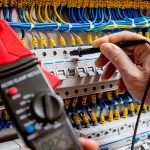Last Updated on 12 months by Francis
In the field of electrochemistry, there is often confusion surrounding the terms electromagnetic force (EMF) and cell potential. While these two concepts are closely related, they are not exactly the same thing. In this essay, we will explore the similarities and differences between EMF and cell potential, and how they influence our understanding of electrochemical reactions.
Contents
Understanding EMF and Cell Potential
Electromotive force, or EMF, is a term that describes the electrical potential difference between two points in a circuit. This potential difference is created by the presence of an electric field, which can be generated by a variety of sources, including batteries, generators, and even living organisms. On the other hand, cell potential, also known as electrode potential, is a term used to describe the potential difference between an electrode and the solution in which it is immersed. This potential difference arises due to the chemical reactions occurring at the electrode surface.
While both EMF and cell potential involve potential differences, they are not the same thing. EMF is a measure of the potential difference between two points in a circuit, while cell potential is a measure of the potential difference between an electrode and a solution.
The Relationship Between EMF and Cell Potential
Despite their differences, there is a relationship between EMF and cell potential. In fact, the two are related through the Nernst equation, which describes the relationship between the concentrations of species involved in redox reactions and the resulting electrode potential.
The Nernst equation is given by:
E = E_0 – (RT/nF)ln(Q)
Where E is the cell potential, E_0 is the standard electrode potential, R is the gas constant, T is the temperature, n is the number of electrons transferred in the redox reaction, F is the Faraday constant, and Q is the reaction quotient.
The equation shows that the cell potential depends on the standard electrode potential, as well as the concentration of species involved in the redox reaction. As such, changes in the concentration of these species can lead to changes in the cell potential.
EMF and Health Effects
Electromagnetic fields, or EMFs, are a type of radiation that are generated by the movement of electrically charged particles. These fields can be found in a variety of sources, including power lines, cell phones, and Wi-Fi routers. While there is still much debate surrounding the health effects of EMFs, some studies have suggested that exposure to high levels of EMFs may be linked to certain health problems, such as cancer and neurological disorders.
The Debate on EMF Health Effects
The debate surrounding the health effects of EMFs has been ongoing for many years. While some studies have suggested that exposure to high levels of EMFs can have harmful effects, others have found no such association. As such, the scientific community remains divided on the issue.
One of the main concerns surrounding the health effects of EMFs is their potential to cause DNA damage. This is because EMFs are known to have a high energy level, which can lead to the production of free radicals. Free radicals are highly reactive molecules that can cause damage to cells and DNA.
The Precautionary Principle
Given the ongoing debate surrounding the health effects of EMFs, some organizations have adopted the precautionary principle when it comes to EMF exposure. The precautionary principle is a principle that states that in situations where the potential for harm exists, it is better to err on the side of caution and take steps to reduce exposure.
As such, some organizations have recommended limiting exposure to EMFs, particularly for vulnerable populations such as children and pregnant women. This can include measures such as using wired rather than wireless devices, keeping cell phones away from the body, and avoiding the use of electronic devices before bed.
EMF Shielding
Another approach to reducing exposure to EMFs is through the use of EMF shielding. EMF shielding refers to the use of materials that can block or absorb EMFs. Some common materials used for EMF shielding include conductive metals such as copper and aluminum, as well as conductive fabrics and paints.
While there is some evidence to suggest that EMF shielding can be effective in reducing exposure to EMFs, it is important to note that not all EMF shielding materials are created equal. In order to be effective, EMF shielding materials must be properly installed and grounded.
FAQs: Is EMF the Same as Cell Potential?
What is EMF?
EMF stands for electromotive force, which is essentially the voltage generated by a battery or an electrochemical cell. This voltage is the driving force for current flow in a circuit and is measured in volts (V).
What is Cell Potential?
Cell potential, also known as the electrode potential, is the difference between the half-cell potentials of the two electrodes in an electrochemical cell. It is typically measured in volts (V) and is an indication of the potential for a reaction to occur at the cell.
Are EMF and Cell Potential the Same Thing?
EMF and cell potential are related concepts, but they are not exactly the same thing. EMF refers to the voltage generated by a battery or electrochemical cell, while cell potential is a measure of the potential difference between the two half-cells.
How are EMF and Cell Potential Related?
The EMF of an electrochemical cell is equal to the difference in cell potential between the two half-cells when the cell is not conducting any current. Once current begins to flow, however, the cell potential will change and may be different from the EMF.
Why is it Important to Distinguish Between EMF and Cell Potential?
Understanding the difference between EMF and cell potential is important in electrochemistry because it can help researchers and engineers better optimize the performance of batteries, fuel cells, and other electrochemical devices. By measuring and controlling the cell potential, it is possible to maximize the efficiency and longevity of these devices.




.jpg)


